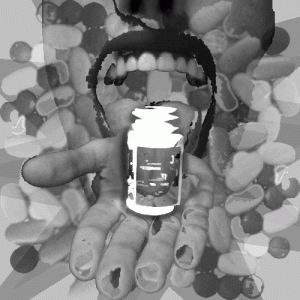I have a lot of respect for the great medical minds of the past few centuries. Great geniuses have given (first world) humanity the gift of extended, comfortable lives by grace of a careful understanding of the human body, chemistry and fungus.
However, like with so many other miracles made possible by modern technology, ignorance mixed with excess has turned a gift into a hazard. The industry of modern medicine, specifically modern pharmaceuticals, typifies this familiar bleak turn.

Like any social institution, responsibility for its condition lands on the producers and the consuming populace alike. Everyone involved is playing their role perfectly. While moralizing about big pharmaceutical companies can be a cathartic exercise of self-righteousness, it has been done to death and usually leads only to a vague sense of despair. Musing about the warped nature of modern drug consumption, on the other hand, is something that all of us consumers can relate to and affect, if only just a little bit.
Each of us has been conditioned since birth to view a remedy as something to be bought and consumed. This isn’t an unreasonable belief—I know drugs have worked miracles throughout my own life—but it’s one of the many reasons that, today, prescriptions are being pushed for any given irritating character trait.
We laugh at medieval medicine, their leeches and their mysticism, but how much do we really know about the power and danger of modern medications? We take their word, take their pill, then wait for the miracle. This ignorance is unavoidable, to a degree. Something as powerful as modern medication is not going to be simple enough to intuitively understand. It’s the excess that follows it that’s the manageable danger.
Insulin and penicillin were once the cornerstones of the budding, twentieth century pharmaceutical industry; drugs designed to combat violent, fatal infections. Only half a century later, in 1963, Valium redefined what a well marketed drug could be. Today the list of best sellers is dotted with remedies for preventable conditions exacerbated by habits that are permitted, if not encouraged, by society. Among the bestsellers is Shire Pharmaceutical’s hit ADHD solutions, Adderall and Vyvanse.
As with any business, high sales requires heavy demand. With no one to draw the line and define the notion of a treatable illness but those producing the cure, it stands to reason that demand just might be inflated to increase sales. We are surrounded by medication not only for our own health, but for the financial success of those invested in production.
Students nationwide ruthlessly abuse Adderall and Ritalin to bolster academic performance. How many know that this highly publicized drug is a relative of one of the most stigmatized drugs in the nation: Methamphetamine? Both amphetamine-class stimulants are considered wildly addictive by the FDA, and one of them is prescribed to children as young as 3 years old.
Studies are still being conducted as to whether or not regular amphetamine salt consumption stunts creativity. Yet, more consideration is still given daily to the long term effects of a mediocre diet than a socially sanctioned drug addiction.
Now, I’m not trying to get you to neglect your meds and meditate to lower your fever, only to consider the act of ingesting for just a second longer. Consider looking up what the medication is actually doing to your physiology before eating it. Consider, if possible, trying to change the aspects of your life that bring on the demand for a cure, if not preemptively, simultaneously to being medicated. Ultimately, that is the only lasting cure to the illnesses superfluous drugs counteract.
Wonderful beat ! I wish to apprentice whilst you amend your site, how can i subscribe for a weblog site? The account aided me a acceptable deal. I had been a little bit acquainted of this your broadcast provided brilliant clear concept